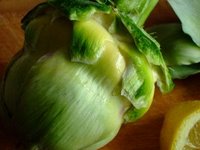
2006 is the centenary of the birth of John Betjeman, poet. He was a popular poet, in the sense that the people understood and loved him and he loved Cornwall, particularly the little church of St Enodoc, above the wonderful beach at Daymer, near Rock,(see above).
 St Enodoc's Church was rescued in the nineteenth century from the sand that had engulfed it - in order to celebrate its consecration the vicar had to be lowered through a skylight - and now stands in the middle of a rather posh golf course.
St Enodoc's Church was rescued in the nineteenth century from the sand that had engulfed it - in order to celebrate its consecration the vicar had to be lowered through a skylight - and now stands in the middle of a rather posh golf course." A mile of sunny, empty sand away,
A mile of shallow pools and lugworm casts.
Safe, faint and surfy, laps the lowest tide."

Betjeman is buried in its tiny churchyard, his ornate gravestone near the lych gate with its lead topped stone the shape of a coffin, a pause for the funeral procession to get in line.
I'm enjoying freshly boiled lobster and great fish dishes, but nobody should leave Cornwall without saffron cake. The Cornish people traded their tin with the Phoenicians for saffron, and the traditional saffron cake - a fruited tea bread heavy with the yellow spice - is available everywhere. I didn't make it, but I am certainly eating a lot of it!

People had left stones on Betjeman's grave, and I did too, whispering "This is from Joan Hunter Dunn" as I did so. I think saffron cake would have been her sort of thing, if she could have got it in Aldershot.
Furnish'd and burnish'd by Aldershot sun,
What strenuous singles we played after tea,
We in the tournament-you against me!
Love-thirty, love-forty, oh! weakness of joy,
The speed of a swallow, the grace of a boy,
With carefullest carelessness, gaily you won,
I am weak from your loveliness, Joan Hunter Dunn.
Miss Joan Hunter Dunn, Miss Joan Hunter Dunn,
How mad I am, sad I am, glad that you won.
The warm-handled racket is back in its press,
But my shock-headed victor, she loves me no less.
Her father's euonymus shines as we talk,
And swing past the summer-house, buried in talk,
And cool the verandah that welcomes us in
To the six-o'clock news and a lime-juice and gin.
The scent of the conifers, sound of the bath,
The view from my bedroom of moss-dappled path,
As I struggle with double-end evening tie,
For we dance at the Golf Club, my victor and I.
On the floor of her bedroom lie blazer and shorts
And the cream-coloured walls are be-trophied with sports,
And westering, questioning settles the sun
On your low-leaded window, Miss Joan Hunter Dunn.
The Hillman is waiting, the light's in the hall,
The pictures of Egypt are bright on the wall,
My sweet, I am standing beside the oak stair
And there on the landing's the light on your hair.
By roads 'not adopted', by woodlanded ways,
She drove to the club in the late summer haze,
Into nine-o'clock Camberley, heavy with bells
And mushroomy, pine-woody, evergreen smells.
Miss Joan Hunter Dunn, Miss Joan Hunter Dunn,
I can hear from the car-park the dance has begun.
Oh! full Surrey twilight! importunate band!
Oh! strongly adorable tennis-girl's hand!
Around us are Rovers and Austins afar,
Above us, the intimate roof of the car,
And here on my right is the girl of my choice,
With the tilt of her nose and the chime of her voice,
And the scent of her wrap, and the words never said,
And the ominous, ominous dancing ahead.
We sat in the car park till twenty to one
And now I'm engaged to Miss Joan Hunter Dunn.
John Betjeman
























